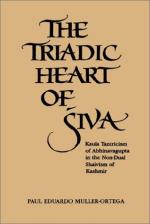|
This section contains 959 words (approx. 4 pages at 300 words per page) |

|
From the second half of the ninth century CE, Tantric Śaivism in Kashmir advanced in various forms into the front line of Brahmanical thinking. Learned authors superimposed upon roughly homogenous groups of scriptural traditions uniform systems of metaphysics and soteriology that could be defended not only against each other but also against the major non-Śaiva doctrines of the time. By the tenth century the Śaiva scene was dominated by the confrontation of two radically opposed schools: on the one hand, a group of nondualistic traditions, principally the Trika and the Krama, and on the other, the dualistic Śaiva Siddhānta. The nondualists, upholding the doctrine that the world and persons are no more than the play of the power of a universal consciousness-self, operated from within transgressive cults "tainted" by the Kāpālika culture of the cremation grounds...
|
This section contains 959 words (approx. 4 pages at 300 words per page) |

|




